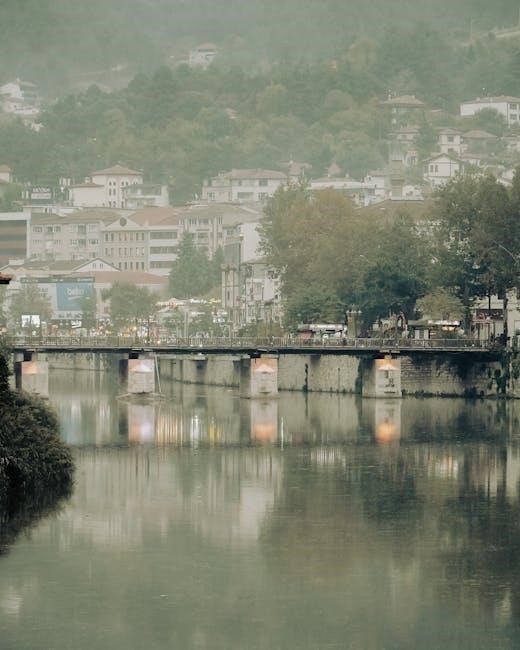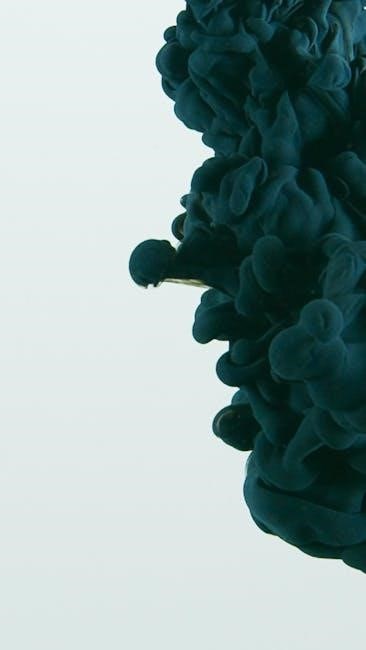The Color of Water PDF explores the significance of water color‚ examining factors like clarity‚ sediment‚ and depth. It highlights cultural and environmental impacts‚ offering insights into conservation and sustainability.
1.1 Overview of the Document
The Color of Water PDF is a comprehensive guide exploring the significance of water color‚ its variations‚ and its implications. It delves into scientific explanations‚ cultural symbolism‚ and environmental factors influencing water clarity. The document examines how geographic location‚ climate‚ and human activities shape water color‚ providing insights into regional differences. It also discusses the impact of pollutants‚ algae‚ and seasonal changes on water clarity. Additionally‚ the PDF highlights the cultural and symbolic meanings of water color‚ from art and literature to spiritual and marketing contexts. By addressing both natural and human-induced factors‚ the document aims to raise awareness about water quality and conservation. It serves as a valuable resource for understanding the complex relationship between water color and its surroundings‚ offering a holistic view of this essential natural resource.
1.2 Importance of Water Color Analysis
Water color analysis is crucial for understanding environmental health‚ as it reflects the presence of pollutants‚ sediments‚ and biological activity. Changes in water color can indicate contamination‚ algae blooms‚ or sediment runoff‚ which affect aquatic ecosystems. Analyzing water color helps monitor water quality‚ ensuring safe drinking water and recreational use. It also aids in detecting climate change impacts‚ such as shifts in ocean productivity. Additionally‚ water color influences light penetration‚ affecting photosynthesis and marine life habitats. Accurate analysis supports conservation efforts‚ helping mitigate human-induced changes like eutrophication and deforestation effects. By studying water color‚ scientists can develop strategies to protect water bodies‚ preserving biodiversity and maintaining ecological balance. This analysis is vital for sustainable water management and addressing global challenges related to water clarity and quality.
1.3 Purpose of the PDF Document
The purpose of The Color of Water PDF is to provide a comprehensive understanding of water color dynamics‚ their causes‚ and their implications. It serves as an educational resource‚ detailing the science behind water color and its significance in environmental monitoring. The document aims to bridge the gap between scientific research and public awareness‚ offering insights into how human activities and natural factors influence water clarity. It also highlights the importance of water color analysis in conservation efforts and sustainable water management. By exploring regional variations and cultural perspectives‚ the PDF document seeks to inspire action toward protecting water bodies and preserving their aesthetic and ecological value. Ultimately‚ it acts as a guide for policymakers‚ researchers‚ and the general public to foster a deeper appreciation for water as a vital resource;
The Science Behind Water Color
The science behind water color involves light absorption‚ particle interaction‚ and depth effects. These factors determine how water appears‚ from deep blues to murky browns‚ influencing its aesthetic and ecological significance.
2.1 Light Absorption and Reflection in Water
Light absorption and reflection are key factors in determining water color. When sunlight enters water‚ shorter blue wavelengths penetrate deeper‚ while longer red wavelengths are absorbed near the surface. This selective absorption and scattering of light give water its blue appearance. However‚ the presence of particles‚ sediments‚ or algae can alter this process‚ reflecting different wavelengths and changing the water’s color. For instance‚ sediment-rich waters often appear brown or green due to reflected light from suspended particles. Depth also plays a role‚ as deeper waters absorb more light‚ intensifying the blue hue. Understanding these interactions is crucial for analyzing water color variations and their implications for aquatic environments and human activities.

2.2 Role of Particles and Sediments
Particles and sediments play a significant role in determining water color by scattering and absorbing light. Suspended particles‚ such as sand‚ silt‚ and algae‚ reflect sunlight in various wavelengths‚ altering the water’s appearance. For example‚ high levels of sediments can give water a murky‚ brownish hue‚ while algae blooms often create green or blue-green colors. These particles also interact with light absorption‚ reducing water clarity and affecting the depth at which light penetrates. Natural factors like erosion and human activities such as deforestation can increase sediment runoff‚ further impacting water color. Understanding the role of particles and sediments is essential for analyzing water quality and environmental changes‚ as they provide insights into the health and conditions of aquatic ecosystems.
2.3 Impact of Depth on Water Color
Water depth significantly influences its color due to variations in light penetration and absorption. In deeper waters‚ light travels further‚ scattering shorter blue wavelengths more intensely‚ creating a darker‚ bluer appearance. Conversely‚ shallow waters reflect light from the bottom‚ often displaying green or brown hues due to sediment or vegetation. Depth also affects the visibility of submerged objects‚ as light intensity diminishes with increasing depth. This interplay between light‚ depth‚ and surrounding environments shapes the visual characteristics of water bodies‚ making depth a critical factor in understanding water color dynamics and their ecological implications.

Factors Influencing Water Color

Geographic location‚ climate‚ and seasonal changes significantly impact water color. Pollutants‚ algae‚ and sediment levels also play a role‚ affecting clarity and hue in various aquatic environments globally.
3.1 Geographic Location and Climate
Geographic location and climate significantly influence water color. Tropical regions often have clear‚ blue waters due to low sediment levels‚ while arctic areas may appear murky from glacial runoff. Coastal areas with high rainfall experience increased sediment‚ altering water hues. Desert regions‚ with limited rainfall‚ often have clearer waters. Climate-driven factors like hurricanes or monsoons can stir up sediments‚ changing water color. Seasonal variations‚ such as algae blooms in warmer months‚ also impact water clarity and color. These geographic and climatic factors create diverse water color patterns‚ reflecting local environmental conditions and influencing ecosystems and human activities alike.

3.2 Presence of Pollutants and Algae
The presence of pollutants and algae significantly alters water color‚ impacting its clarity and aesthetic appeal. Pollutants such as chemicals‚ industrial waste‚ and agricultural runoff introduce suspended particles‚ creating murkier hues. Algae blooms‚ often triggered by nutrient-rich waters‚ can turn water green‚ brown‚ or even red‚ depending on the algae type. These changes not only affect visibility but also harm aquatic life by depleting oxygen levels. In coastal areas‚ excessive algae growth can lead to dead zones‚ further degrading water quality. The interplay of pollutants and algae highlights the delicate balance of aquatic ecosystems and underscores the need for sustainable practices to mitigate their harmful effects on water color and overall environmental health.
3.3 Seasonal Variations in Water Clarity
Seasonal changes significantly influence water clarity‚ affecting its color and transparency. In spring‚ melting snow and heavy rainfall increase sediment levels‚ reducing clarity and giving water a murkier appearance. Summer often brings algae blooms‚ which can tint water green or brown‚ depending on the algae type. Autumn introduces organic matter like fallen leaves‚ further altering water color. Winter typically sees clearer water due to reduced biological activity and sediment settling. These seasonal variations highlight the dynamic nature of water ecosystems‚ emphasizing the importance of monitoring and understanding these changes to maintain water quality and biodiversity. By studying these patterns‚ we can better address environmental challenges and promote sustainable water management practices.

Regional Variations in Water Color
Regional water color varies significantly across oceans‚ lakes‚ and rivers‚ influenced by sediment‚ algae‚ and depth. Coastal areas often display unique hues due to mixed freshwater and saltwater conditions.
4.1 Ocean Water Color
Ocean water color varies widely‚ from deep blues in open waters to greens and browns near coasts. Factors like sediment‚ algae blooms‚ and depth influence these hues. Coastal areas often appear murkier due to sediment runoff‚ while open oceans reflect deeper blues. Seasonal changes‚ such as phytoplankton blooms‚ can shift colors dramatically. Human activities‚ including pollution and climate change‚ also impact ocean color‚ affecting marine ecosystems. The Jersey Shore‚ for instance‚ experiences clarity variations due to environmental conditions. Additionally‚ cultural perceptions of ocean colors‚ like the “Mocha Mousse” trend‚ highlight their symbolic significance. Understanding these variations aids in monitoring water health and addressing conservation efforts‚ as highlighted in “The Color of Water PDF.”
4.2 Freshwater Lakes and Rivers

Freshwater lakes and rivers exhibit a wide range of colors‚ from crystal-clear blues to murky browns‚ influenced by sediment‚ algae‚ and depth. In glacial lakes‚ fine sediments create turquoise hues‚ while rivers often appear brown due to soil runoff. Algae blooms can turn waters green or even red‚ affecting clarity and ecosystems. Geographic location and climate play a significant role‚ with tropical rivers often carrying more sediment. Human activities‚ such as deforestation and pollution‚ alter water color by increasing sediment and nutrient runoff‚ leading to eutrophication. Seasonal variations‚ like spring snowmelt‚ further change water clarity. These factors highlight the dynamic nature of freshwater systems‚ as discussed in “The Color of Water PDF‚” emphasizing the need for conservation to maintain water quality and biodiversity.
4.3 Coastal and Estuarine Waters
Coastal and estuarine waters display unique color variations due to the mixing of freshwater and seawater. Sediments from rivers often create turbid‚ brownish hues‚ while algae blooms can produce vibrant greens or reds. Depth and sunlight penetration also influence color‚ with shallower waters appearing brighter. Estuaries‚ as transition zones‚ experience dynamic changes in water color due to tidal movements and seasonal runoff. Human activities‚ such as dredging and pollution‚ further alter these ecosystems‚ affecting clarity and biodiversity. The interplay of natural and anthropogenic factors makes coastal waters particularly sensitive to environmental changes. “The Color of Water PDF” underscores the importance of monitoring these areas to mitigate impacts and preserve their ecological balance‚ ensuring sustainable coexistence of marine life and human activities.
Human Impact on Water Color

Human activities like pollution‚ deforestation‚ and climate change significantly alter water color. Increased sediments and nutrient runoff lead to algal blooms‚ reducing clarity and affecting aquatic ecosystems globally.
5.1 Pollution and Eutrophication
Pollution and eutrophication significantly impact water color by introducing excess nutrients‚ such as phosphates and nitrates‚ which stimulate algal blooms. These blooms turn water green or brown‚ reducing clarity and harming aquatic life. Industrial waste‚ agricultural runoff‚ and sewage are major contributors‚ altering ecosystems and affecting oxygen levels. Eutrophication leads to dead zones‚ where fish and plants cannot survive‚ further changing water color. Coastal areas are particularly vulnerable‚ with nutrient-rich runoff causing persistent algal growth. This not only affects aesthetics but also threatens biodiversity and human health. Addressing pollution and eutrophication is critical for maintaining clear‚ healthy waters and preserving aquatic habitats. Efforts to reduce nutrient runoff and treat wastewater are essential to mitigate these effects and restore water clarity.
5.2 Deforestation and Sediment Runoff
Deforestation significantly impacts water color by increasing sediment runoff. Tree removal disrupts soil stability‚ leading to erosion during rainfall. Sediments like silt‚ clay‚ and organic matter enter water bodies‚ making them murkier and altering their natural color. This runoff also carries nutrients‚ contributing to algal growth‚ which further changes water color. Rivers and lakes near deforested areas often appear brown or cloudy due to suspended particles. This affects aquatic life by reducing sunlight penetration‚ disrupting photosynthesis‚ and harming habitats. Additionally‚ sediment runoff can carry pollutants‚ exacerbating water quality issues. Efforts to replant trees and implement soil conservation practices are crucial to reducing sediment runoff and preserving water clarity. Addressing deforestation is essential for maintaining healthy‚ clear waters and mitigating its cascading effects on ecosystems and human activities.

5.3 Climate Change Effects
Climate change significantly alters water color through various mechanisms. Rising temperatures cause thermal expansion‚ changing ocean water color as warmer waters often appear lighter. Melting ice and glaciers introduce freshwater‚ altering salinity and color patterns. Ocean acidification affects marine life‚ reducing phytoplankton populations that influence water hue. Additionally‚ climate-driven storms increase sediment runoff‚ clouding waters. These changes impact ecosystems‚ with shifts in water color affecting light absorption and photosynthesis. Coastal regions experience more frequent algal blooms‚ further altering water color. Monitoring these changes is crucial for understanding climate impacts on aquatic environments. Efforts to mitigate climate change must address its effects on water clarity and color to protect marine biodiversity and maintain ecological balance. The interplay of temperature‚ sediment‚ and biological factors underscores the complex role of climate change in shaping water color globally.
Cultural and Symbolic Significance of Water Color
Water color holds deep cultural and symbolic meaning‚ reflecting spirituality‚ art‚ and literature. Its hues evoke emotions‚ influencing human perception and connecting us to nature’s beauty and life-giving essence.
6.1 Water Color in Art and Literature
Water color has long inspired artists and writers‚ symbolizing life‚ tranquility‚ and transformation. In art‚ it is often used to evoke emotions‚ from the calmness of a serene lake to the power of ocean waves. Literature frequently employs water color metaphorically‚ representing clarity‚ depth‚ or spiritual renewal. The vibrant hues of coastal waters and the murky tones of polluted rivers have been central themes in many works‚ reflecting humanity’s connection to nature. By capturing the essence of water’s visual appeal‚ creators continue to explore its symbolic and aesthetic significance‚ making it a timeless subject in both visual and written media.
6.2 Spiritual and Religious Symbolism
Water color holds profound spiritual and religious significance across cultures. In many traditions‚ water is seen as a symbol of purification‚ renewal‚ and divine connection. Its clarity often represents spiritual purity‚ while turbidity may signify impurity or chaos. In Christianity‚ baptism uses water to symbolize rebirth and cleansing of sins. Similarly‚ in Hinduism‚ the Ganges River is revered for its purifying properties. The color of water‚ whether crystal-clear or richly hued‚ is often linked to emotional and spiritual healing. Rituals worldwide‚ such as blessings or sacred baths‚ emphasize water’s role in connecting humanity to the divine. The Color of Water PDF explores these themes‚ highlighting how water’s visual properties reflect its deeper spiritual meanings and its enduring role in religious practices and beliefs.
6.3 Water Color in Marketing and Branding
Water color plays a significant role in marketing and branding‚ influencing consumer perceptions and emotional connections. Brands often use water-inspired hues to evoke feelings of purity‚ calmness‚ and refreshment. For instance‚ clear blue tones are commonly associated with trust and serenity‚ making them popular in beverage and wellness industries. The color of water in packaging and advertising can also convey sustainability and environmental consciousness‚ aligning with modern consumer values. Additionally‚ vibrant water colors are used to create dynamic and eye-catching campaigns‚ especially in sectors like tourism and sports apparel. The strategic use of water color in branding helps companies build a visual identity that resonates with their target audience‚ enhancing brand recognition and appeal. This approach highlights how water’s aesthetic properties are leveraged to communicate brand values and capture market attention effectively.
The color of water holds significant ecological and cultural value‚ influencing ecosystems and human activities. Future research and technology will enhance water color analysis‚ aiding conservation and sustainability efforts globally.
7.1 Summary of Key Findings
The analysis of water color reveals its complexity‚ influenced by natural factors like sediment‚ depth‚ and light interaction‚ as well as human activities such as pollution and deforestation.
Regional variations show distinct characteristics in oceans‚ freshwater bodies‚ and coastal areas‚ highlighting the role of geography and climate.
Cultural significance is evident in art‚ spirituality‚ and marketing‚ where water color symbolizes purity‚ life‚ and beauty.
The findings underscore the need for conservation efforts to maintain water clarity and address environmental challenges like eutrophication and climate change.
Technological advancements promise improved monitoring and analysis‚ offering hope for sustainable water management and ecological balance.
7.2 Conservation Efforts for Water Clarity
Conservation efforts for water clarity focus on reducing pollutants‚ sediments‚ and harmful algal blooms.
Strategies include implementing stricter regulations on industrial and agricultural runoff‚ promoting sustainable land-use practices‚ and restoring natural habitats like wetlands.
Education campaigns raise awareness about the importance of clean water‚ encouraging communities to adopt eco-friendly behaviors.
Technological solutions‚ such as advanced filtration systems and monitoring tools‚ play a crucial role in maintaining water quality.
Collaborative efforts between governments‚ NGOs‚ and local stakeholders are essential for long-term success.
By addressing both human impact and natural factors‚ these initiatives aim to preserve the aesthetic and ecological value of water bodies for future generations.

7.3 Technological Advances in Water Color Analysis
Technological advancements have revolutionized water color analysis‚ enabling precise and efficient monitoring of water bodies.
Satellite imagery and drones now provide high-resolution data on water color‚ helping identify changes in clarity and pollution levels.
Multispectral and hyperspectral imaging technologies allow scientists to detect subtle variations in water color‚ linked to factors like algae blooms or sediment levels.
Portable spectrophotometers and handheld devices enable real-time field measurements‚ making data collection more accessible and cost-effective.
Artificial intelligence and machine learning algorithms are being used to analyze large datasets‚ predicting water quality trends and identifying potential threats.
These innovations not only enhance accuracy but also facilitate global monitoring‚ aiding in the conservation and sustainable management of water resources.
